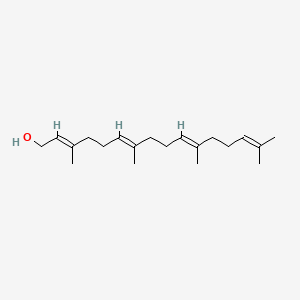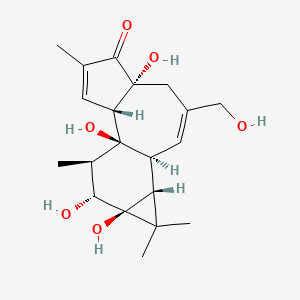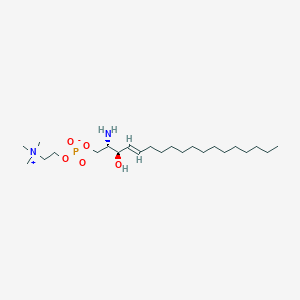
|
Geranylgeraniol |
Geranylgeraniol is a lipid of Prenol Lipids (PR) class. Geranylgeraniol is associated with abnormalities such as abnormal fragmented structure, Hyperostosis, Diffuse Idiopathic Skeletal and Tuberculosis. The involved functions are known as Positive Regulation of Apoptosis, Anabolism, Prenylation, Apoptosis and pathologic cytolysis. Geranylgeraniol often locates in Body tissue, Cytoplasmic matrix, Red Cell Ghost, Spindle and Nuclear lamin. The associated genes with Geranylgeraniol are MST1 gene, STN gene, UMOD gene, ABCA1 gene and RHOA gene. The related lipids are Sterols, Hydroxycholesterols, SK&F 104976 and 25-hydroxycholesterol. |
403 |

|
forskolin |
Forskolin is a lipid of Prenol Lipids (PR) class. Forskolin is associated with abnormalities such as Cholestasis, Vocal cord dysfunction familial, Hypothyroidism, Renal tubular disorder and Disintegration (morphologic abnormality). The involved functions are known as Cell Proliferation, Anabolism, mRNA Expression, Agent and Signal. Forskolin often locates in Extracellular, Body tissue, Skin, Tissue membrane and Membrane. The associated genes with forskolin are P4HTM gene, SLC33A1 gene, NR1I2 gene, Genes, Reporter and CYP3A gene. The related lipids are Steroids, steroid sulfate, Fatty Acids, LYSO-PC and Lipopolysaccharides. |
24755 |

|
Phorbol |
Phorbol is a lipid of Prenol Lipids (PR) class. Phorbol is associated with abnormalities such as furuncle, Infection, endothelial dysfunction, Morphologically altered structure and Acute erythroleukemia. The involved functions are known as Tyrosine Phosphorylation, Metabolic Inhibition, Transcription, Genetic, Protein Biosynthesis and Signal. Phorbol often locates in Tissue membrane, Membrane, Cell surface, soluble and Cytoplasmic Domain. The associated genes with Phorbol are STAT3 gene, JAK2 gene, JUN gene, PROC gene and MAPK8 gene. The related lipids are Lipopolysaccharides, Phosphatidylserines, Liposomes, Fatty Acids and Octanols. |
2082 |

|
phorbol 13-acetate 12-myristate |
Phorbol 13-acetate 12-myristate is a lipid of Prenol Lipids (PR) class. The involved functions are known as DNA Fragmentation, Phosphorylation and Irritation. Phorbol 13-acetate 12-myristate often locates in low-density lipoprotein particle. The associated genes with phorbol 13-acetate 12-myristate are FPR1 gene and ABCB1 gene. |
40921 |

|
Sphingosine 1-phosphate |
Sphingosine 1-phosphate is a lipid of Sphingolipids (SP) class. Sphingosine 1-phosphate is associated with abnormalities such as Infection, Painful Bladder Syndrome, Atherosclerosis, Hyperglycemia and Rheumatoid Arthritis. The involved functions are known as Phosphorylation, Regulation, enzyme activity, Energy Absorption and Vascular Permeability. Sphingosine 1-phosphate often locates in Endothelium, Tissue membrane, Vascular System, Protoplasm and Microfilaments. The associated genes with Sphingosine 1-phosphate are MBTPS1 gene, FBXL15 gene, TEK gene, NTRK1 gene and Gene Family. The related lipids are Promega, Lipopolysaccharides, lysophosphatidic acid, Lysophosphatidylcholines and Lysophospholipids. The related experimental models are Knock-out, Mouse Model, Transgenic Model, Disease model and Experimental Autoimmune Encephalomyelitis. |
2005 |

|
sphingosylphosphorylcholine |
sphingosylphosphorylcholine is a lipid of Sphingolipids (SP) class. Sphingosylphosphorylcholine is associated with abnormalities such as Cerebral Vasospasm, Subarachnoid Hemorrhage, Atherosclerosis, Hypertensive disease and Niemann-Pick Diseases. The involved functions are known as MAP kinase kinase activity, JUN kinase activity, Phosphorylation, biphenyl synthase activity and Cell Death. Sphingosylphosphorylcholine often locates in Adipose tissue, Protoplasm, Body tissue, Membrane and Extracellular. The associated genes with sphingosylphosphorylcholine are UCN3 gene, MAPK9 gene, JUN gene, NAA50 gene and P4HTM gene. The related lipids are Lysophospholipids, lysophosphatidic acid, Lysophosphatidylcholines, Sphingolipids and Saponin. The related experimental models are Mouse Model. |
265 |

|
cholesterol |
cholesterol is a lipid of Sterol Lipids (ST) class. Cholesterol is associated with abnormalities such as Trypanosomiasis, Chagas Disease, Cleft Palate, Chondrodysplasia punctata 2, X-linked dominant and Child syndrome. The involved functions are known as Blood Circulation, Sterol Biosynthesis Pathway, Receptor Mediated Endocytosis, Methylation and Signal. Cholesterol often locates in Animal tissue, Blood, Membrane, Plasma membrane and peroxisome. The associated genes with cholesterol are MBD2 gene, SIM, SLC33A1 gene, Genome and NSDHL gene. The related lipids are Sterols, zymosterol, fecosterol, Total cholesterol and 7-dehydrocholesterol. The related experimental models are Mouse Model, Knock-out, Genetically Engineered Mouse and Disease model. |
98461 |






